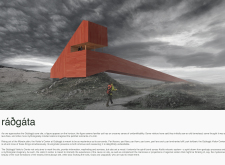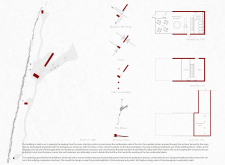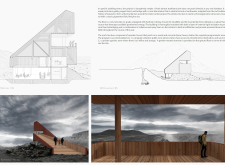5 key facts about this project
The Grjótagjá Visitor Center is located in the volcanic area of Mývatn, Iceland, serving as a key point for visitors exploring the nearby Grjótagjá caves. The design connects the building with the unique landscapes and rich folklore of the region. It functions not only as a place for information but also as a space that enhances the experience of the surrounding natural features. The visitor center provides essential services while evoking the local stories that have grown around this intriguing geographical site.
Spatial Organization
- The layout of the visitor center clearly separates parking from the cave entrances. This design directs visitors to walk along a landscaped path as they make their way to the caves. After parking, visitors pass through an archway formed by a ramp that leads to the Karlagjá cave entrances. This arrangement allows for easy movement through the space while aligning the building with important geological landmarks. The gentle slope of the ramp helps make the center accessible for everyone, including those with mobility challenges.
Structural Design and Materials
- The visitor center combines simplicity with purpose in its design. A main public zone serves as the gathering point for visitors, offering refreshments and information in a shared space. A private area on the upper level contains offices and storage, improving the center’s functionality. The gradual incline of the ramp leads visitors upward and provides views of the impressive landscape that surrounds them, connecting them with the natural environment.
Energy Efficiency
- The building incorporates sustainable design elements through careful material selection and energy-saving strategies. The facade features a Norwegian pine rainscreen that not only adds character but also contributes to energy efficiency. Beneath, the concrete floor includes hydronic tubing that provides radiant heating, which is ideal given the area's geothermal resources. Rigid insulation helps prevent energy loss, while additional layers further ensure the building remains comfortable throughout the year. These choices reflect a commitment to responsible design that reduces environmental impact.
Geological Engagement
- The design concludes with a strategic elevation that allows visitors to take in the view of the tectonic divide between the North American and Eurasian plates. This significant aspect of the design immerses visitors in the geological context of the region. The building’s careful placement and thoughtful configuration highlight the relationship between human-made structures and the natural world, fostering an understanding of the area’s geological history.
The Grjótagjá Visitor Center illustrates a mindful approach to design that prioritizes the connection between architecture and the landscape. Its features enhance the overall experience for visitors, inviting them to appreciate both the built environment and the remarkable natural setting.






















































